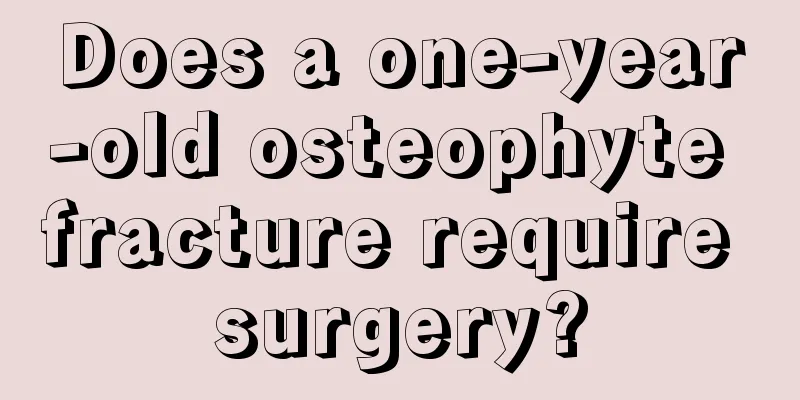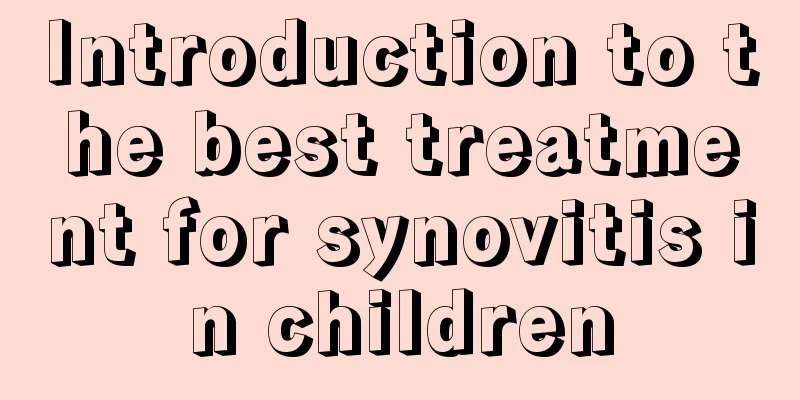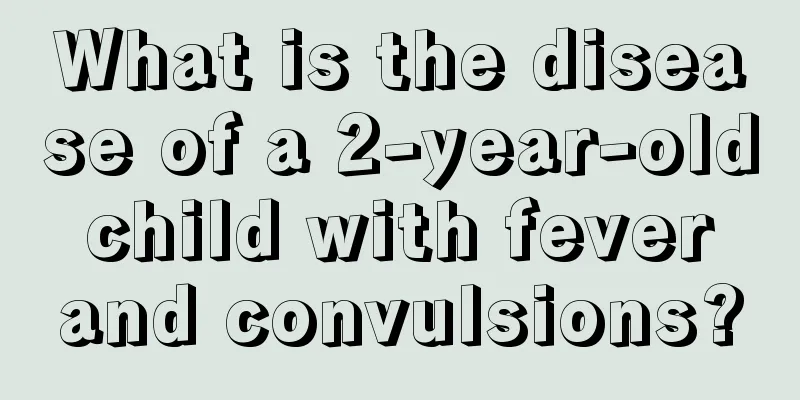Does a one-year-old osteophyte fracture require surgery?

|
For a one-year-old child, the body is very fragile because the bones are not fully developed. Many of them are in the early development of epiphyses, which are very fragile and can easily lead to fractures. Some people undergo surgery to correct a posterior femoral fracture. But in actual situations, because the bones of a one-year-old child can recover very quickly, surgery is not required. Only bone fixation and recovery are needed. Below are specific instructions for this situation. I hope it can help everyone deal with the same problem. The epiphysis is the part of bone that grows before it matures. It has an ossification center in the center and cartilage around it.Limb buds can be seen in the fifth week of human embryogenesis, and the rudiments of limb cartilage can be recognized in the sixth week. Blood vessels enter the cartilage when the embryo is three months old, followed by the appearance of osteoclasts and osteoblasts, intracartilage ossification begins, and a bone marrow cavity appears. There is an active growth area at each end away from the medullary cavity, which is called the epiphysis. A fracture is an interruption or destruction of the integrity or continuity of a bone. Those caused by trauma are called traumatic fractures; if the bone itself is affected by a certain disease, it can cause fractures even under very slight external force, which is called pathological fracture. After proper treatment after fracture, most patients can recover their original functions, but a few patients may have sequelae of varying degrees. Treatment of epiphyseal injuries 1. Handling principles: Type I and II injuries are mainly treated with closed reduction. Only unstable fractures or those with failed reduction due to soft tissue embedding in the fracture ends require surgical treatment. Children have strong bone shaping abilities, so there is no need to force anatomical reduction, as most of them can correct themselves spontaneously as they grow and develop. Type III and IV injuries are intra-articular fractures, which require restoration of joint surface flatness and epiphyseal alignment and often require surgical treatment. For type III injuries with mild original displacement, manual reduction can be attempted, but surgery is not required if the fracture is stable. Type V injuries are difficult to diagnose early. Suspected cases should be locally immobilized for 3 to 4 weeks and the affected limb should be kept from bearing weight for 1 to 2 months. (1) Reduction method Closed reduction should be performed under general anesthesia to allow the muscles to completely relax and the overlapping bone ends to be fully retracted. The reduction technique should be gentle, and violent compression of the epiphyseal plate should be avoided to avoid iatrogenic epiphyseal trauma. For overlapping and displaced fracture ends that are difficult to completely overcome, the "folding top" method should be used for reduction. (2) Timing of reduction: The earlier the fracture is reduced, the better; delay will increase the difficulty of reduction. For those whose injuries last more than 7 to 10 days, forced reduction should not be performed, especially for type I and II injuries, which should be left for osteotomy at a later date. For old fractures that are more than two weeks old, there is a risk of damaging the epiphyseal plate even with open reduction. Therefore, type I and II injuries should be corrected by two-stage surgery as much as possible, and type III and IV injuries should be reduced openly as much as possible. (3) Fixation method: Do not peel off the perichondrium around the epiphyseal plate during open reduction to avoid damaging the chondrocytes and blood supply in the Ranvier zone. Do not use instruments to pry or compress the epiphyseal plate to reduce the epiphyseal plate. It is advisable to use Kirschner wires for internal fixation, and they should be inserted perpendicular to the epiphyseal plate as much as possible, and never penetrate the epiphyseal plate laterally. Screws can only be used to fix the epiphysis or larger secondary ossification centers and should not pass through the epiphyseal plate, otherwise bone bridges may form in the local cavity after the screws are removed, thereby inhibiting local bone growth. The internal fixation device should be removed promptly after bone healing. 4. Timing of removing fixation: The healing speed of epiphyseal fractures is similar to that of metaphysis, about 3 to 4 weeks, which is only about half the healing time of the same bone shaft. Type IV fractures are unstable and prone to delayed healing or non-healing. X-rays must be taken to confirm fracture healing before fixation can be removed. After removing fixation for lower limb fractures, practice joint movements first and delay weight bearing appropriately. 5. Follow-up physicians should warn the child's family that this injury may cause bone growth disorders and that the final results can only be concluded after 1 to 2 years, emphasizing the importance of long-term follow-up.
(1) For type I and II injuries, closed reduction should be performed early. The reduction should be gentle and rough to avoid further epiphyseal injury. There is no need to force anatomical reduction; residual deformities can be corrected later through reconstruction. For example, in the case of angular deformity, the normal physiological stress stimulates the epiphyseal plate, which responds differently in different epiphyseal plate areas. In order to make the stress pass vertically through the joint surface, the epiphyseal plate grows selectively in an eccentric manner, and the concave side of the angle grows faster than the convex side, so that the angular deformity is gradually corrected. The maximum acceptable angulation is 30°, but rotation cannot be corrected. (2) The main treatment for type III and IV injuries is open reduction and internal fixation. Sometimes type III is well aligned, relatively stable, and can be treated non-surgically. During open reduction, the blood supply of the epiphysis must be protected, and extensive periosteum and soft tissue stripping should not be performed for the sake of clear exposure. This is because it may damage the activity of cells around the Ranvier zone, resulting in premature epiphyseal closure. Do not use blunt instruments to compress the epiphysis to reposition it to avoid aggravating the injury. (3) Epiphyseal injury repairs quickly. The healing time of types I to IV is approximately half of the healing time of epiphyseal fractures. Therefore, the later the epiphyseal injury is, the more difficult it is to reduce it. If the injury lasts more than 10 days, it is almost impossible to reduce type I and II injuries manually. Violent reduction or open reduction may damage the epiphyseal plate. Therefore, for type I and II injuries that persist for more than 10 days, do not attempt manual reduction. Allow the deformity to heal and then correct it by osteotomy. Type III and IV injuries are different. Displaced old injuries are bound to cause growth disorders. In order to achieve anatomical reduction and joint surface flattening, delayed open reduction should also be implemented. (4) Follow-up Children with epiphyseal injuries should be followed up regularly until the epiphysis matures. Sometimes the growth of the epiphyseal plate does not stop completely immediately after trauma, but grows slowly for 6 months after the injury and then stops. In some cases, growth disorders may not manifest until puberty. The patient should be closely observed within 2 years after injury, and X-rays should be taken every 1 to 2 years thereafter. (5) Prognosis ① Type of injury. ② The age of the child at the time of injury: If the injury is improperly treated or severe, epiphyseal growth disorders may occur. The younger the child is, the more severe the deformity will be in the future.③Epiphysis blood supply: the worse the blood circulation, the worse the prognosis, especially for the femoral head and radial head. ④ Treatment methods: Rough manipulation or using instruments to pry the displaced epiphysis may cause growth disorders. ⑤ Infection after open epiphyseal plate injury will inevitably lead to destruction and premature closure of the epiphyseal plate. ⑥ Traction epiphyseal injury. The ligaments and tendons attached to this epiphysis can cause avulsion of the epiphysis due to sprain or sudden muscle contraction, such as avulsion of the medial epicondyle of the humerus and avulsion of the lesser trochanter epiphysis of the femur. These injuries do not cause |
<<: When do boys' chicks grow hair?
>>: Biliary atresia is one year old
Recommend
What should children eat if they have a hoarse throat?
Many parents often find that their children have ...
How to cure indigestion in babies
Indigestion is a common disease among children. T...
How to remove phlegm from children’s throats?
Many children do not know how to get rid of phleg...
What are the symptoms of poor digestion in children?
It is quite common for children to have poor dige...
What are complicated febrile seizures in children?
The health of children in the family may directly...
What are the symptoms of intestinal necrosis in babies?
Intestinal necrosis is a very serious disease, bu...
An expanded introduction to rheumatoid arthritis in children
Not only adults can suffer from rheumatoid arthri...
What is facial dermatitis in children?
What parents worry about most for children is der...
Baby malnutrition
When the body is malnourished, it is easy to caus...
Eight-month-old baby's eye bags are red
The red eye bags of eight-month-old babies are ma...
Nursing and treatment of hydrotesticular effusion in infants
The phenomenon of hydrotesticular effusion in inf...
What to do if your child stutters
Stuttering is a symptom that some children will e...
Why does my five-month-old baby have a lot of eye mucus?
Normally, when people have too much eye mucus, it...
What should I do if my child has a dry cough? Moms can do this!
Dry cough is a common lung system disease in chil...
Baby's hair is bald at the back
A baby is the fruit of a couple's love and is...









